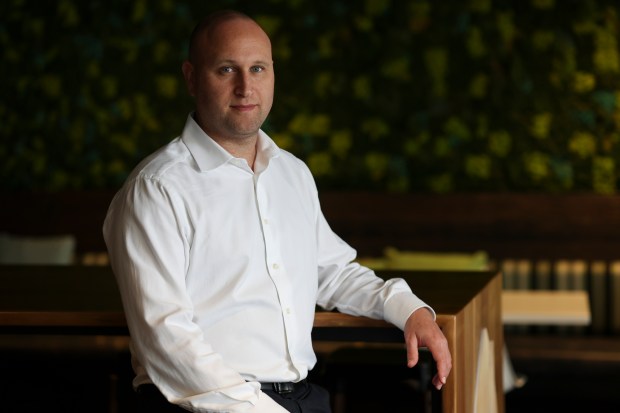A pioneering Chicago tech company is celebrating its 20th anniversary this year, and no, it’s not Groupon.
From a humble origin story, Grubhub launched the multi-billion dollar U.S. online food delivery industry, which exploded in popularity during the pandemic, sating the cravings of locked-down consumers for everything from avocado toast to quesadillas.
For millions of Americans, especially Millennials, who comprise nearly half the market, ordering dinner online has become part of their daily routine, thanks in no small part to Grubhub.
Founded in 2004 by Chicago software engineers Mike Evans and Matt Maloney as a way to move restaurant menus from the cluttered kitchen drawer to an organized website, Grubhub started with a single merchant — a now-closed Uptown Chinese restaurant — building what would become a national e-commerce platform. Then came a splashy IPO and eventually a buyout worth billions, the classic startup fairy tale.
But as growth slows in the post-pandemic landscape, Grubhub finds itself lagging behind competitors DoorDash and Uber Eats, owned by a Dutch-based company Just Eat Takeaway, which is trying to sell it, and looking to a new CEO to help it regain market share and its startup mojo.
Welcome to your 20s, Grubhub.
“Grubhub invented the industry in North America,” said Grubhub CEO Howard Migdal, 37, a seasoned online food delivery executive who joined the company last year. “But the reality is, we have really good competitors and customers’ expectations are very high. And we need to meet and exceed those expectations to earn the trust of our customers.”
Two decades after changing the way consumers order restaurant delivery, Grubhub is celebrating its anniversary with a special promotion through the end of the month. Major national partners such as Taco Bell, Wendy’s, Panera, Pizza Hut, Popeyes and McDonald’s are each giving away 20,000 free items on designated days with minimum orders, adding everything from Big Macs to personal pan pizzas at no charge.
But like other groundbreaking Chicago tech startups, coming of age has been filled with challenges for Grubhub, which has seen annual revenue declines since peaking at the start of the pandemic in 2020. The broader food delivery industry, while decelerating, continues to grow.
Last year, North America revenue for Grubhub’s parent company, Just Eat, fell by 16% to about $2.3 billion, according to financial reports. Just Eat does not break down revenue for Grubhub, its largest North American holding.
Food delivery services saw a huge spike in revenue during the pandemic, jumping from $3.8 billion in 2019 to $8.5 billion in the U.S. after stay-at-home orders hit the following year, according to data from market research firm IBISWorld.
Revenue has continued to climb at a slower pace in the post-pandemic environment, with food delivery services projected to generate $13.9 billion in revenue this year, according to IBISWorld.
Total U.S. consumer spending on food delivery tops $90 billion per year, according to KeyBanc Capital Markets.
San Francisco-based leaders DoorDash has 67% and Uber Eats 23% of the meal delivery market, according to an April report by Bloomberg Second Measure. Grubhub is a distant third at 8% of sales, but is more competitive in its core markets such as Chicago and New York.
Grubhub works with 375,000 merchants in over 4,000 U.S. cities, including 15,000 in Chicago alone – the most of any food delivery service, Migdal said.
Since arriving in Chicago last year, Migdal has implemented both cost-cutting measures and initiatives aimed at reversing the revenue slide. Topping the top-line list is an expanded partnership with Amazon, which it has been working with since 2022.
In May, Amazon was granted rights to increase its existing equity stake in Grubhub up to 18% while enabling customers to order restaurant food delivery on its website. As part of the five-year deal, Amazon Prime shoppers were also given free Grubhub+ loyalty memberships, reducing delivery fees.
“We’re very proud of the Amazon partnership,” Migdal said. “Amazon is among the most customer-obsessed organizations in the world, and their goal is to give as much value to Prime members as possible. And they know restaurants is a very big category they currently don’t play in.”
A Detroit native and Michigan State graduate, Migdal co-founded GrubCanada in 2008, an online food delivery service patterned after Grubhub. GrubCanada was acquired by Just Eat in 2011 and Migdal spent most of the next decade as a top online food delivery executive north of the border, before moving to Chicago and joining Grubhub as CEO in March 2023.
Grubhub launched in March 2004 after signing up Charming Wok, its first Chicago restaurant, to market food delivery through the service. Like online dealmaker Groupon, Grubhub quickly became a centerpiece of the Chicago tech scene, and an influential platform for the burgeoning e-commerce industry.
In 2014, Grubhub filed for an initial public offering raising $193 million and valuing the company at north of $2 billion. Co-founder Evans left Grubhub that year to “pursue other opportunities.”
Just Eat gobbled up Grubhub for $7.3 billion in 2021. Maloney, who served as CEO throughout most of Grubhub’s history, left the company months after the new owners took possession. By April of 2022, Just Eat was already shopping Grubhub amid declining revenue and market share.
During its April 2024 quarterly financial update, Just Eat said it “continues to actively explore the partial or full sale of Grubhub.” It is unclear how the May deal enabling Amazon to increase its stake up to 18% over five years would impact the potential full sale of Grubhub going forward.
Meanwhile, Grubhub has been downsizing both its headcount and office space.
In June 2023 Grubhub laid off 15% of its workforce, which now stands at about 750 employees in Chicago and 2,400 overall.
Grubhub, which has occupied five floors at the Burnham Center on Washington Street in the Loop since 2012, is moving by the end of the year to a smaller space on one floor at the Merchandise Mart. With a hybrid work schedule and a smaller workforce, Grubhub is trading down from 160,000 square feet to 90,000 square feet at its new headquarters.
“Merchandise Mart is an awesome historic building in Chicago,” Migdal said. “One of the reasons I love our new space is we can get all 750 employees on one floor, which is fantastic.”
Beyond economic issues, the company is also dealing with the overhang of lawsuits brought by the city of Chicago against Grubhub and DoorDash in 2021, alleging the food delivery services engaged in deceptive business practices by overcharging and misleading customers during the pandemic.
Three years later, the Grubhub case is still wending its way through the discovery process in Cook County Circuit Court. The DoorDash case was moved to Chicago federal court in September 2021, where it is ongoing as well.
“We remain deeply disappointed by the city’s decision to file this lawsuit,” Grubhub said in a statement. “Every allegation is wrong, and we will continue to defend our business.”
Grubhub is not the only struggling Chicago e-commerce pioneer. Last year, Groupon, once the center of the Chicago tech ecosystem, issued a going concern warning amid operating losses and dwindling cash reserves, and announced a move from its massive River North headquarters to a 25,000-square-foot space at the Leo Burnett building in the Loop.
While Grubhub built its business on restaurant delivery, the path forward may involve diversifying its offerings, Migdal said. Last month, Grubhub announced a new partnership with Albertsons enabling it to deliver groceries from 1,800 stores nationwide, including Jewel-Osco in Chicago.
Down the road, Grubhub expects its 200,000 drivers across the U.S. to deliver a lot more than grub, adding other kinds of merchants to the ecosystem, Migdal said.
“When you talk about the next 20 years, what we’ve really created is a really powerful logistics network,” Migdal said. “We’re one of very few companies that can get sort of anything from point A to point B to 85% of Americans in 35 minutes or less.”
rchannick@chicagotribune.com




